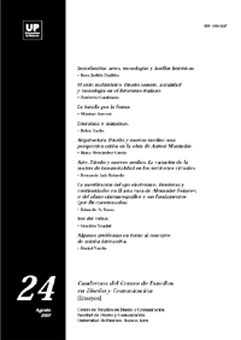Literatura y máquinas
Abstract
In 1982, Walter Ong said writing was a technology that, in contrast to the “naturality” of oral, had the capacity
to reorganize our thought. Throughout its history, literature has dealed with all classes of machinical conceptions:
of the human being, language, writing and even literature it self. This text will deal with some of the ways in
which writers have used machines to shape their works, from average media as the press or the typewriter to
particular devices like Hausmann´s Optofon or Marcel Duchamp´s the Rotatives. Net-poetry, on the other hand,
appears today as the heiress of a series of literary experiences with gramófonos, telegraphs, radios, telephones,
videocameras, etcetera
References
- Burroughs, William. (1967). The ticket that exploded. New York: Grove Press.
- Calvino, Italo. (1983). Cibernética y fantasmas. En Punto y aparte. Barcelona: Bruguera.
- Derrida, Jacques. (1987). Ulysses gramophone. Paris: Galilee.
- Gache, Belén. (2006). Escrituras nómades, del libro perdido al hipertexto. Gijón: Trea.
- Joyce, James. (1975). Finnegan’s Wake. London: Faber and Faber.
- Khlebnikov, Velemir. (1985). Radio of the future. En Collected Papers. Cambridge: Harvard University Press.
- Mc Luhan, Marshall. (1964). Understanding Media. New York: McGraw-Hill.
(1962). The Gutenberg Galaxie: the making of typographic man. Toronto: University of Toronto Press.
- Ong, Walter. (1982). Orality and Literacy: The Technologizing of the Word. London: Methuen.
- Oulipo. (1988). La Littérature Potentielle. Paris : Gallimard.
- Swift, Johnathan. (1998). Gulliver’s Travels. Oxford: Oxford University Press.
Los autores/as que publiquen en esta revista ceden los derechos de autor y de publicación a "Cuadernos del Centro de Estudios de Diseño y Comunicación", Aceptando el registro de su trabajo bajo una licencia de atribución de Creative Commons, que permite a terceros utilizar lo publicado siempre que de el crédito pertinente a los autores y a esta revista.


